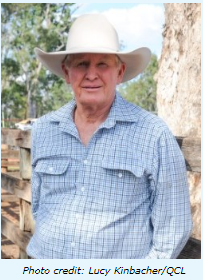Twenty years of LPA
After two decades providing quality and safety assurance for Australia’s red meat industry, the Livestock Production Assurance (LPA) program is delighted to celebrate the significant and exciting milestone of reaching its twentieth year.
Around 175,000 cattle, sheep and goat producers participate in the LPA program nationally and each undertakes to run their on-farm practices in line with the LPA program’s seven requirements, including risk assessments, animal safety, feed stock, preparation for and recording of animal movements, animal welfare and biosecurity.
Global focus on farm integrity
 In 2003, Patrick Hutchinson, CEO of the Australian Meat Industry Council (AMIC) was a senior manager at Meat & Livestock Australia (MLA), and together with Allan Bloxsom, General Manager of MLA’s Industry Systems Group, Patrick was a driving force behind the establishment of the LPA program in 2004.
In 2003, Patrick Hutchinson, CEO of the Australian Meat Industry Council (AMIC) was a senior manager at Meat & Livestock Australia (MLA), and together with Allan Bloxsom, General Manager of MLA’s Industry Systems Group, Patrick was a driving force behind the establishment of the LPA program in 2004.
Following outbreaks of Bovine Spongiform Encephalopathy (BSE) and foot-and-mouth disease (FMD) in Europe in 2001, the integrity of on farm systems had become a key focus of global markets by 2002.
“Providing assurance had become a massive issue for both the processing and export sectors,” Patrick said. “That really pushed MLA to start developing a program with some real teeth to stand up to the rigour our global markets were demanding.”
Throughout 2003/04, Patrick and the Industry Systems team worked at breakneck speed to create the LPA program and deliver a communications campaign that would see it successfully launched and on farm in 2004.
The initial response
To begin with, the new requirements of the LPA program weren’t popular with producers.
Patrick recalls it being a tough time but said the support of the MLA Board and Allan Bloxsom, together with the old LPA Advisory Committee never wavered.
“There was real pressure from a regulatory perspective because we had to have a response to these issues that had being happening in other parts of the world,” Patrick said.
“We weren’t responsible for those issues obviously, but it was critical that we could demonstrate the unparallelled integrity of our farm systems if we were going to continue promoting ourselves globally.”
“That’s as true in 2024 as it was in 2004. We’ve seen that very recently with the Lumpy Skin Disease (LSD) and FMD issues in Indonesia that emerged last year, demonstrating that Australia can never be complacent.”
Delivering value
MLA’s State of the Industry Report for 2023 estimated that red meat and livestock production (beef cattle, sheep farming and feedlots) now accounts for around $42 billion (55%) of the industry’s overall turnover, across both our export and domestic markets.
“The value of the LPA program should be obvious, because it’s kept us in these markets by providing the confidence governments and customers are looking for with red meat, when many others have failed,” Patrick said.
“Australia is the world’s most reliable red meat supplier, and we want to retain that position. Our global customers want a reliable and thriving Australian red meat industry as well, but they also want confidence that we are meeting as many of their requirements as possible.”
|
A producer’s perspective
“I don’t think it’s possible to overstate the importance of the LPA, firstly because it's underpinned by a robust auditing system, but also because it’s the one document that follows your livestock through to the point of processing.” Food safety is central The LPA underpins livestock health credentials from start to finish and provides extensive information about any on farm activities (e.g. chemical usage, feed stock, and HGPs) that pose a risk. “We might be livestock producers, but we mustn’t lose sight of the fact that what we are really dealing in is a food product, first and foremost,” Peter said. “To succeed, we have to be able to guarantee the safety of that Despite the level of certainty it delivers, Peter said producers were fortunate in that the program was a relatively simple one and there was comparatively little effort required to comply with the LPA’s food safety standards. Improved record keeping While easy to use, producers understand participation in the LPA requires more detailed records to be kept of their on farm day-to-day activities and Peter said the industry has become more efficient in their record keeping as a result. “It’s very simple to use and comply with. You can fill it out on the spot and send it straight out along with the consignment,” he said. “Of course, there’s still going to be issues with messy handwriting, but the electronic NVD will help improve that and deliver clearer, more concise information.” “I think we've been very lucky to have had the LPA underpinning our industry and enabling us to demonstrate, beyond a doubt, the quality, safety and provenance of our red meat for the past 20 years.” |
Envy of the world
 ISC’s Manager - Quality, Policy and Compliance, Elizabeth Bradley, said the LPA (together with the NVD and the NLIS) underpins a strong product integrity system that provides a consistent, single source of truth for Australia’s red meat supply chain integrity.
ISC’s Manager - Quality, Policy and Compliance, Elizabeth Bradley, said the LPA (together with the NVD and the NLIS) underpins a strong product integrity system that provides a consistent, single source of truth for Australia’s red meat supply chain integrity.
“When our global customers come to us asking questions, they can have confidence our producers have done what they say they’ve done and can produce the evidence to back up their claims,” Elizabeth said.
“In 2004, Patrick ran LPA’s first ever marketing campaign ‘Say what you do, and prove what you say’, and 20 years later we’re still just as committed to that original message.”
That message is central to the role LPA’s auditing regime plays in underpinning commercial and industry-based brands, which in turn underpin the programs that support massive buying companies, both domestically and internationally.
“With tens of billions of dollars at stake, the industry can’t afford to be complacent about food safety and quality assurance. It must be able to evolve and respond to market demands moving forward, whatever they may be.”
Looking to the future
The LPA does more than provide assurance that red meat producers have complied with market expectations, it also works to support producers in acquiring the knowledge and skills required to meet those expectations.
“We are continually looking at what the market appetite is and developing modules and education that reflect this,” Elizabeth said. “This focus on supporting producers to grow their skills will continue to expand in line with evolving market expectations and help ensure that Australian red meat remains the protein of choice.”
Global consumers are now demanding more of Australia’s red meat, particularly in growth areas such as animal welfare and sustainability.
“As an industry, more is being asked of us - more information, more data and more confidence in our products – and the LPA must reflect that if we’re to retain our place in the global market and continue to produce value for our producers,” Elizabeth said.
“While the LPA has helped propel the industry forward over the past 20 years, we are also mindful that the world is changing and, just as we did in 2004, we need to ask our people to keep developing with it.”
More information
Livestock Production Assurance (LPA) | Integrity Systems
LPA Record Keeping Booklet: LPA-farm-records-book (integritysystems.com.au)
Information about the LPA NVD: National Vendor Declaration (NVD) | Integrity Systems
 Cloncurry cattle producer and AgForce Cattle President, Peter Hall, has been trading cattle for more than four decades. He’s been with the LPA program since its inception and believes the LPA is the red meat industry’s single most important document.
Cloncurry cattle producer and AgForce Cattle President, Peter Hall, has been trading cattle for more than four decades. He’s been with the LPA program since its inception and believes the LPA is the red meat industry’s single most important document.